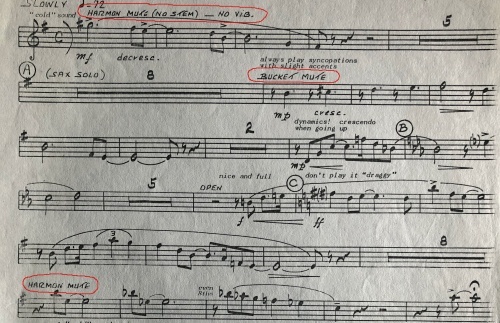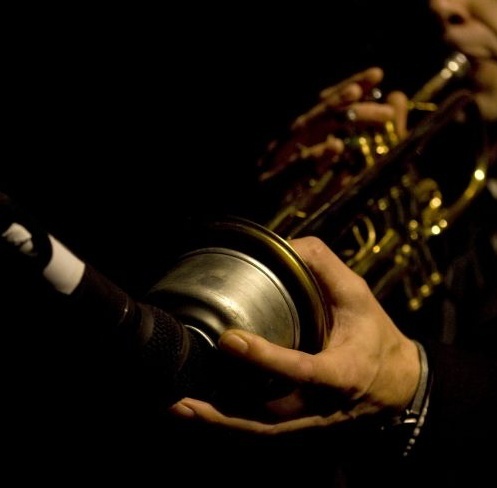Trumpet Mute
How do you change the sound of your trumpet? Just put something in the end of your bell right? Wait. Then nothing would come out. Or would it?
What do you put on the end of a trumpet?
Easy. A mute. Mutes are called for during different parts of music scores by the arranger when they want to change the timbre (tone quality) and/or lower the volume. They soften the brightness of the trumpet and some mutes warm the sound. Funny thing, mutes are named for their shape and not how they sound. Don’t you just love the English language where a word can have so many different uses and meanings. For example, the word “mute” /myoot/ can be:
- An adjective “due to an injury, he can’t talk and is now mute”.
- A verb “to deaden, muffle, or soften the sound of.”
- A noun “A pad or cone placed in the opening of a brass or other wind instrument to soften the sound.”
Yep, the last one makes more sense for our discussion. A mute for a trumpet (or cornet and less so for the flugelhorn) does just that, it softens the sound coming out of your horn. The primary reason they are used however is to alter or change the “color” of your sound for a passage of music or song. The sound can be just made a bit softer. Mutes have been around a long time. They moved from classical to contemporary music with their use in jazz music with the popularity of players like Miles Davis.
Click the link below to jump straight to what you are looking for.
- How do you use a trumpet mute?
- How do you notate a muted trumpet?
- How many types of trumpet mutes are there?
- Best Straight Mutes
- Best Cup Mutes
- What is a Harmon Mute?
- What is the best Harmon mute?
- How do you mute a trumpet at home?
- Best Practice Mutes
What is a mute for a trumpet?
The most common mute for a trumpet is called a “straight” mute. It’s a closed cone with three cork strips on the end that goes into your bell. The cork strips do two things. First, it’s what holds the mute in the bell. The second, and most important thing, is that it gives some of your sound a way to go around the mute. A “straight” mute has a hold on the top that goes into your bell and is closed at the bottom. This combination of “muted” and unmuted change the way you sound altogether. There are exceptions to this like the Harmon mute that has cork that seals your bell which forces all the sound to go into the mute.
Mutes are made of different materials with the most common being of cardboard, aluminum, copper, and various plastics. The main difference being the ones made out of metal sound much brighter.
How do you use a trumpet mute?
The cork on the mute is designed to gently hold it in place while you play. To make sure the cork doesn’t damage the finish of your bell, make sure the corks are clean before inserting the mute. The best thing to do is to blow into your bell like you are trying to fog a mirror. This puts some moisture from your breath in your bell which helps the cork slide into place easier. You may find (especially with straight mutes) that you are sharp (higher in pitch) than without a mute in. Tune your trumpet with your mutes so if you need to adjust your main tuning slide, you’ll know how much is needed. If you find your mutes corks aren’t holding it in place, they may have become slick. You can use some fine sandpaper to gently remove a very slight amount of the cork. Always store your mutes in your case or in a protective bag when not in use and they should last a lifetime.
How do you notate a muted trumpet?
When you are reading music that requires a mute, how do you know? Thankfully it’s composers and arrangers write things like “Straight Mute”, “Cup Mute”, and “Harmon Mute” above the staff. You’ll know exactly when to insert which mute and when. Here’s an example of some sheet music I had.

How many types of trumpet mutes are there?
There are quite a few different mutes as you can image. Music composers explore how to change the sound of the trumpet and that has resulted in many different types of mutes and mutes made with different materials.
The most common is the Straight Mute. It’s a straight cone or with a soft, almost pear like shape. The red and white one that you’ll see in most middle and high schools is the Humes & Berg Stonelined Straight Mute. In orchestras and symphonies, you’ll see trumpet players using straight mute made of metal. Usually aluminum, copper, or a combination. They provide a bright tone, giving your notes a bit of “sizzle”. The Denis Wick aluminum is one of the most popular straight mutes. It’s intonation and brightness earns it high praise by many.
Affiliate disclosure: As an Amazon Associate we earn qualifying purchases. This is to help support this site. This means if you click on links on reviewed products, we may earn a small commission on your purchase from Amazon. Please note that your price does not increase because of this. Thank you in advance for supporting the band.
The other most common types of mutes:
- Bucket Mute– These are large mutes which you’ll find in many jazz arrangements. They make it sound like you are playing into a bucket. The sound is dark and warmer. There are two styles. The first looks like a straight mute with cylinder on the end. The other clips onto the bell rim.
- Plunger Mute. You know that red rubber plunger that you unclog your toilet with? Yes, that’s the one. Unscrew the handle and you have a plunger mute. The rubber ones are most often used in Dixeland music you’ll hear in New Orleans jazz clubs. You create a “Wah wah” effect by placing the mute over your bell and fanning it open and closed.
Best Straight Mutes
Humes & Berg Stonelined Straight Mute
This is an easy to blow through mute and is the most commonly called for mute by arrangers. If you dug through a bunch of trumpet cases and the owner had just one mute, chances are it’ll be white with red trim. It’s the Humes & Berg stonelined straight mute. The sound is very well known in the industry. With their durability and inexpensive cost, Humes and Berg mutes are far and away the most popular in middle through high school bands. Best of all, when you drop them, they don’t dent like metal ones (and boy did I drop mine in high school).

Denis Wick Aluminum Straight Mute
This aluminum straight mute has a brighter tone than the Humes & Berg above. One note: Check with your band director and/or your fellow trumpet players on which mute they are playing. Consistency of color is important. The Denis Wick straight mute is our top pick for a metal straight mute because of it’s intonation and cost.

Best Cup Mutes
When you were digging through those trumpet cases, if the players had more than one mute, they would have a cup mute. Again, the most common one would be white with red trim. This is the Humes & Berg Stonelined Straight Cup Mute. It’s similar to a straight mute but with a cup on the end that covers the bell with a small gap between the rim. This softens the sound of your trumpet. The Humes & Berg Stonelined cup mute has the “sound” most composers are looking for, so it is the one you’d use most. Competing for the best cup mute is the Denis Wick Adjustable Cup Mute. It too has the “sound” that is looked for and it’s really versatile. You can move the cup closer to the rim of the bell to soften and darken your sound more. You can remove the cup completely and can use it as a straight mute if you forgot yours. You can even use it as a practice or warm-up mute by moving the cup against your bell. Humes & Berg Stonelined Straight Cup Mute

Denis Wick Adjustable Cup Mute
At 1:15 you can see Andrea Motis playing the Denis Wick Adjustable Cup mute. Alba’s solo starts at 1:18.

Vincent Bach Straight Cup Mute
If the second trumpet mute you found wasn’t the Humes & Berg one or the Denis Wick Adjustable Cup Mute, it would be a Vincent Bach Straight Cup Mute. The reason is, it’s plastic and super durable. How durable? Go look at the first picture for this post. The one sitting on the trumpet method books I bought over 50 years old and still works. Yep, that durable and still sounds great.

What is a Harmon Mute?

A Harmon mute is also known as a “Wah-wah” mute. It’s known as a Harmon mute because Paddy Harmon perfected the original in the big band era of the 1920’s. This is the type of mute Miles Davis used for his distinctive sound. The original design is made of aluminum and has cork all around the top. This seals your bell so your notes go through the mute. At the end of the Harmon mute is a small cup with a tube (called the stem) which can be removed. How do you use a Harmon mute? You create the “Wah-wah” sound by placing your left hand over the end of the cup and moving it away from it allow more air and sound to come out.
What is the best Harmon mute?
While the original has a huge following, most prefer the Jo Ral bubble Harmon mute with the Humes & Berg a close second because it’s a more economical alternative. Both have excellence tone quality. The copper Jo Ral has a warmth where the aluminum projects a bit more with it’s brighter tone.
Aluminum Jo Ral Bubble Harmon Mute

Copper Jo Ral Bubble Harmon Mute

Humes & Berg Stonelined Harmon Mute
It has the distinctive sound that most composers and arrangers are looking for. It’s neoprene gasket seals while protecting the finish of your bell. Here’s how it sounds.

How do you mute a trumpet at home?
Our trumpets are designed to be heard, and from far away. That’s great when we are performing, but not so great when you need to play where that making lots of noise isn’t appreciated. Why not stuff your trumpet bell with something? That’s the idea of a practice mute. The hard part is making something that suppresses the sound without making playing feel too different. Different being too hard to blow (too much pressure) or having the notes be so off, it affects your pitch perception. We’ve found these two practice mutes make our family and bandmates much happier than an open bell. You will notice a difference, but the trade off in being able to practice or warm-up at home, back stage, or anywhere you want to be quiet is worth it.
Best Practice Mutes
A practice mute is your gift to your family and neighbors if you don’t have a band room or dedicated practice facility. The more you practice, the better you’ll get so having a way to practice without bothering people is something to invest in. Regular mutes will lower the volume on your trumpet but they also add resistance to your playing.
Best Practice Mute – Budget
Denis Wick Practice Mute
Denis Wick’s practice mute has less blowing resistance and intonation issues that you’ll find with other practice mutes. It looks like a Harmon mute without the stem. Like all practice mutes, it has cork that seals your bell to the mute. It’s got small holes which let your air out so the “back pressure” isn’t as bad as you’d imagine. It makes your trumpet much quieter without sacrificing intonation. Here’s Denis Wick’s promotional video so you can hear the difference yourself.

Yamaha Silent Brass for trumpet/cornet
You’ll find lots of “practice mutes” but the one that everyone agrees is the “one to get” is the Yamaha “Silent Brass” Trumpet Practice Mute system. It’s a “system” because it has an electronic pickup that you can listen to with headphones or feed in your favorite music to play along. The electronics modulate the sound it gets from your trumpet and reproduces it as it would normally sound into your ear buds. It lowers the volume of sound coming out of your trumpet significantly, as much as 90%. This allows you to practice whenever you have the time or feel like it, and that is priceless.
Here’s a full review of the Yamaha Silent Brass by professional jazz trumpet player, Wayne Bergeron


